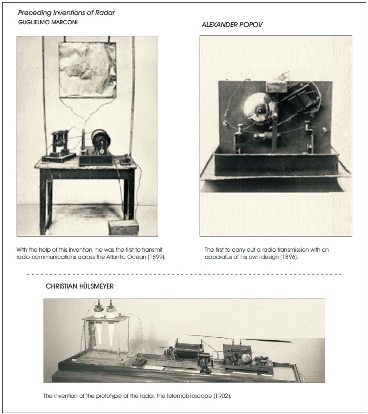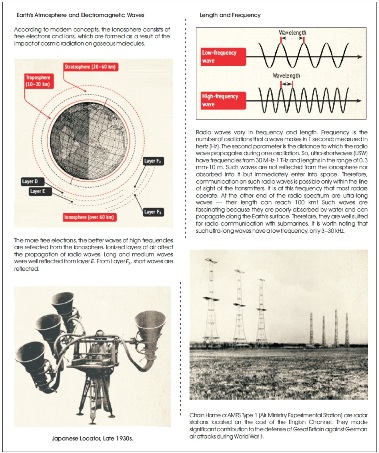RADAR: The All-Seeing Eye
Abstract
All around us, every day, hundreds of radars are at work in planes, ships, airports and even in cars. Invisible radio waves complement our vision efficiently. The history of radar began relatively recently, but it is difficult to imagine life without this technology. This article reviews the science behind the technology and how this technology evolved as what is available in the present.
Keywords :
- Radar,
- Electromagnetic Waves,
- Phased Array,
- Active Electronically Scanned Array,
- Applications of Radar
Introduction
During the two world wars of the twentieth century, the world saw a surge in inventions that applied science, engineering and technology. The objectives of those inventions were either to know what the enemy is planning to do or to destroy the enemy. The invention of radar (acronym of Radio Detection and Ranging) helped both the Axis and the Allies to implement strategies to win the war. After war, most of those inventions including radars ware used to enact peace or for use in improving the living condition of humans.
Inventions evolve and do not happen suddenly, there were so many preceding inventions and discoveries in the basic science that lead the invention of radar. Maxwell's theory indicated and Hertz's experiment confirmed the invisible waves. And then the world is filled with the human created electromagnetic waves and they were carrying communication signals or seeing the invisible from the satellites. Rest of the article, introduces the history, evolution, application, improvements and future scope of radar.
1. Hertz's Experiment and its Impact
“This is just an experiment that proves Maestro Maxwell was right- we just have these mysterious electromagnetic waves that we cannot see with the naked eye. But they are there”, Heinrich Rudolf Hertz once told his student.
The discussion of the history of radar begins with a paradoxical fact: we knew how radio waves acted, bounding off obstacles, before we discovered radio waves themselves. In 1888, the famous German physicist Heinrich Rudolf Hertz, over the course of an experiment, proved that electromagnetic waves can be reflected from metal obstacles. It was like the reflection of sunlight from a mirror. It would only be seven years later, though, when engineers would begin to develop equipment for wireless transmission of information (Alexander Popov in Russia and Guglielmo Marconi in Italy), that the term “radio wave” appeared.
Electromagnetic wavelengths range in length from 0.3 mm to 100 km. Hertz's experiment showed that they can be used for the detection of objects: when it meets an obstacle, a radio wave is reflected o! of it, like rays of light reflecting o! a mirror — all that's left is to “catch” them. A practical embodiment of the radar was patented in 1904 by the German engineer Christian Hulsmeyer. He invented a device called the “Telemobiloscope,” a rotating radio transmitter (antenna) and a receiving device designed to capture reflected radio beams. Such an apparatus was able to detect ships at night through dense fog, which greatly increased the safety of navigation. Radio waves, unlike other electromagnetic waves, practically do not dissipate in bad weather: they do not shy away from fog or snow or rain. This important advantage has predetermined their application for wireless signal transmission over long distances. However, for a long time, radio waves were responsible only for wireless communication.
The situation changed in 1924 when the English physicist Edward Appleton was able to put radar to use for science, determining the height of the Earth's ionosphere by means of radio waves. It turned out that radio emissions of a certain wavelength (from 10 to 100 m) are reflected from the ionized layer of the atmosphere and returned to Earth. Since the speed of propagation of radio waves was known (300000 km/s), the scientist just had to determine the duration for which the reflected radio signal returned to the receiver. For the discovery of the height of the ionosphere — 85 km — Edward Appleton was awarded the Nobel Prize in physics in 1947. Going forward, though, the development of radar would be connected to military science.
2. Sky Watch
From the moment planes began to be armed with guns and bombs, they became detectable in the sights of ground troops, but sounding a timely warning for an air raid was a very difficult task — the fleets of bombers and attackers appeared unexpectedly. At first, they managed to listen to the sky with the help of special sound pickup installations, which allowed them to determine where planes were flying even at night, based on the noise of their engines. But in most cases, these giant “ears” could detect the approach of bombers that were just 15–20 km away, which was not enough for full-fledged counteraction. As soon as the anti-aircraft artillery began to work, their sound completely covered the noise of the enemy aircraft screws, and the sound detectors ceased to function.
Radio waves helped to solve the problem. Disseminating at a speed of 300000 km/s, they can cover airspace of 100–150 km, which even allows intercepting the enemy aircraft. The radar has yet another important ability: direction finding targets. What's that mean? If the special locator focuses radio waves in a narrow beam on the detected target, then the reflected signal can calculate the exact location of the target, or its “bearing.” Such a locator can follow an aircraft throughout its flight — this technique is used not only in military affairs but also in civil air transportation. Any passenger airliner is accompanied by a powerful radar throughout its voyage.
One of the first radar stations was installed in the UK — the Chain Home system, which was largely responsible for British victory in air confrontations with Nazi Germany. In 1935, the first five radars were put into combat duty along the coast of the English Channel: short-wave (10– 13 m) locators operated at frequencies of 20–30 MHz and detected aircraft at distances of more than 60 km. The basis for the work of the Chain Home locators was based on
the pulse principle of irradiation of the target. The transmitter sends radio signals through the radar antenna in short pulses Early Hertz equipment for listening with locators. of 10–15 ms duration, and in the intervals between them, the locator switches to the reflected signal reception mode — “radio echo.” The role of the indicator device is performed by an electron-beam tube, on the screen of which the signal reflected from the flying aircraft is displayed in the form of a burst. For many years, this system was the gold standard of radar stations for detecting air threats. Over time, others appeared, like locators that rotated 360 degrees and therefore could more accurately determine the location of a target in the air.
In 1940, British engineers developed a radar that could detect German bombers at night. They needed to express their military successes to the population of Britain and to the rest of the world without giving out a military secret. John Cunningham, a pilot nicknamed “Cat's Eyes,” was the first to shoot down several enemy aircraft at night with the help of radar, and a Ministry of Defense spokesman told the newspapers that their pilots eat a lot of carrots and therefore can see in the dark. Thus was born the myth about the benefits of carrots on vision.
3. Battle of the Beams
World War II, which broke out in 1939, gave a powerful impetus for the development of high-tech methods of warfare, and radar was no exception. From the very beginning, Nazi Germany savagely bombed British residential areas, while meeting a worthy response from the forces of the British Isles. At some point, the losses of the Luftwaffe (the German air force) were so great that it was decided to move bombings into the dark of night. But how could they determine the precise positioning of defence aircraft in the night sky? The British, after all, feared bombings and strictly observed the night as it cloaked their cities. The Germans adopted a system for nighttime landing, developed by the German company Lorenz in the 1930s, which was used in most airports in the world. The bottom line was that, at night, the locators emitted a narrowly focused radio signal at the rate of the aircraft. Each aircraft coming in for a landing had installed a receiving instrument, tuned to the frequency of the airport. Meanwhile, the radio beam directed at the landing course was not simple. While the plane was on the right landing path (glide path), the radio emitted a monotonous sound, and as soon as the craft shifted to the left or right of the course, the pilot's headphones began to receive the dots and dashes of Morse code. In the prewar decade, thousands of pilots around the world learned to land in complete darkness and in adverse weather conditions based on the Lorenz beam. Based on this principle, the Germans created Lorenzbake locators, which had large capacities. They were directed from the territory of occupied France to the cities of Great Britain, and the pilots could fl y in complete darkness, focusing on the rays of the radar. In later modifications, such as the X-Gerät and Knickebein, another radio beam was added which intersected the primary beam at the point for releasing bombs over England. In this way, on November 14, 1940, the Luftwaffe carried out a barbaric strike on the city of Coventry at night, and many planes dropped their deadly cargo automatically. An apparatus recorded the intersection with the second radio beam and opened the bomb bay directly above the city buildings.
The response of British engineers was not long delayed. The project was codenamed “Aspirin” and included several false radar emitters over the territory of the country, which simply retransmitted the navigation radio waves of the Germans and led the fleets of bombers away from the targets. The British managed to confuse the German crews so much that they often dropped bombs in open fields, and some, trusting their nighttime system, touched down in British airfields in full confidence that they had returned home. This radiolocation confrontation went down in history as the “Battle of the Beams.”




